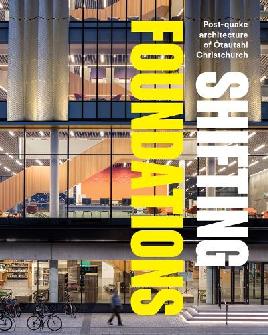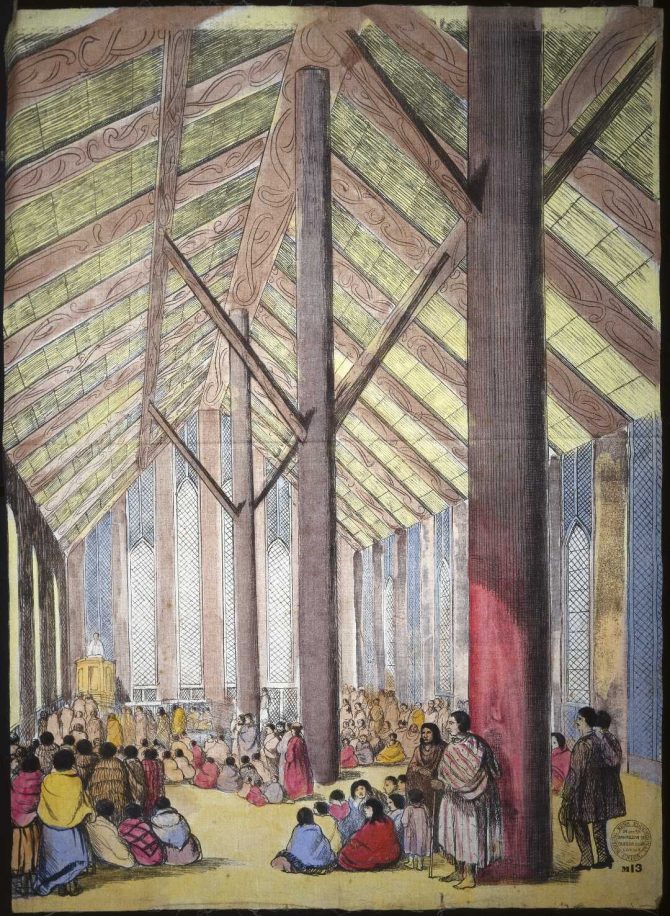A high energy Ray Shipley is on hand to do the introductions and vibe checks for a small but enthusiastic crowd at Little Andromeda on the Saturday night of WORD Christchurch for a session, they inform us, that was originally called "Battle for the Buildings". The book, Shifting Foundations, is the launching off point for 5 different Ōtautahians* to give their perspectives on the best of local architecture and suggest an imaginary building they'd love to see in the city.
First to the front is Joseph Hullen, whose favourite Christchurch building is... Tūranga. I give a whoop from the audience. I know why I like it, but I'm keen to hear why Hullen is a fan.
Hullen went to Xavier Intermediate and spent a lot of time in the central city growing up, between school and bus stops. He remembers being invited to a hui at Spreydon Library where library staff said they wanted to build "your library" - what should we put in it? Hullen is a fan of the bright and bold colours of the first floor children's area but also likes to go up to Tuakiri | Identity, Level 2 for the Māori and Pasifika collections.
Tūranga has exceeded his expectations. How cool is it that you can see Christchurch on a massive AV screen (the Discovery Wall), play videogames or lay down a beat track in the studio? He reminisces about a driving simulator that was available on the ground floor when it opened and his underwhelming lap of Bathurst.
He's also really pleased with the artworks that were incorporated into the building, "we wanted to see our knowledge and stories depicted". He references the mural on the western wall of the building, Tūhura, which depicts Ngāi Tahu ancestor, Paikea.

He talks about Morgan Mathews-Hale's work that wraps around Tūranga lifts, Mātauranga – The Ascent of Tāwhaki, and how the birds depicted on the ground floor are ground-dwelling birds and as you move up the building a different part of the forest canopy is represented.
The Ngāi Tahu narrative of how we get our knowledge is in the building that has all the knowledge... It has something for everybody.
The building Hullen is most looking forward to is papakainga housing that offers opportunities for different generations to live together. The layout is curved so that the community looks at one another, and engages with each other. He punctuates the end of his part of the evening by reflecting on how Matapopore, being wound down, having completed its post-quake work to provide a cultural narrative for the rebuild means a certain politician, should they hold the sway of power post-election, will not be in a position to close it. Based on the finger gestures deployed, and the reaction of the audience, nobody here is voting for that guy.
Sally Blundell is the next to the mic (which over the course of the evening will be adjusted for every speaker by one Juanita Hepi - it's not her responsibility, she just jumps in and does it like a legend). Blundell is a freelance writer and journalist and the author of a book about Ravenscar House and in trying to choose a favourite Christchurch building found that she wasn't happy with all the floor to ceiling glass she saw on display - she wanted to find a "secretive, buttoned-up building" that doesn't reflect what's inside, in same manner as the aforementioned house museum. And so she chose the Japanese Consulate on Hereford Street which is "fortress-like" and which, with its stone exterior and high windows, has a "sense of mystery", especially since she has never been inside.
For her dream building Blundell would like to see a mews, which I have always associated with horses, but which Blundell informed us has its origins in falconry. The housing of horses, it turns out, is a later use which had the benefit of keeping the smell of the horses away from the main house (but not the servants' quarters). Blundell also informs us that Francis Bacon and Agatha Christie lived in mews homes, and with their "U" shape they're a great solution for inner-city housing. They don't look onto streets but at each other (just like Hullen's papakainga housing) and form "intimate neighbourhoods". Many British mews, we are told, have basements - imagine having a shared underground swimming pool. And imagine how the shared courtyard space of a mews could be used - gardens, seating, or even a small playground.
James Tempero is in the Masters writing programme at the University of Canterbury and his feelings about buildings are shaped by earthquakes as he was 10 years old when Christchurch suffered through the quakes. As a result Tempero struggles with anxiety and the pressures inherent in going to places and socialising. In honour of his 10 year old self, his imagined building is the one that young James would have wanted. He apologises that it's not community-focused like Blundell and Hullen's have been. Rather it's a big huge dream mansion with a floor for lollies and a floor for Playstation - all the amusements. The ultimate hangout for him and his childhood friends. It would be located next to the rugby field where Dan Carter trains so he can watch him (10 year old James LOVES Dan Carter).
For his favourite Christchurch building Tempero returns to the anxiety he had in social settings and how he was invited by friends to The Nook Eatery in New Regent Street and though he wasn't keen, he went and had a brilliant time. New Regent Street is his favourite Christchurch building, restored and reopened in 2013.
[New Regent Street is] a rare, beautiful reminder of the old Christchurch... and it has ice cream.

He goes on to the list the many charms of the street including "a tram that goes from one end all the way to the other". There's always something happening there and it is the site of that great night he had, one that was full of laughter and was "an important night and a big step in my own restoration project".
Before introducing the next speaker Ray Shipley, perhaps inspired by Tempero's mention of the tram, throws out a challenge - what if we made the trams free, painted them yellow (like the pre-quake electric buses that ran along Colombo St) and made them run until 1am? The crowd seems keen.
But this isn't where the public transport discourse ends. The next speaker, Erik Kennedy, shows his cards early when he asks how many people in the audience took the bus that evening and then, in full salesman mode says, "Have I got the building for you!"

The bus interchange (Hine-Pāka) is squat and Kennedy likens it to a cat. It is, he says "a nerve-centre" but one that perhaps unfairly, does not have the romantic allure of a train station. Even the greatest bus stations, we are told, "don't get much good press". This he puts down to class-ism before uttering an illustrative quote from Margaret Thatcher that I didn't have time to note down before saying "but she's in the GROUND so who's winning?". I think it's safe to say that based on the audience reaction, there's not a lot of Tories in the room...
Kennedy thinks there is more to the bus interchange than people assume. It's a place where he's seen young people congregating with signs for School Strike 4 Climate rallies, for instance.
There's more to the bus interchange than youth crime!... That should be their slogan.
What's more, how can any car driver rightly feel they have bragging rights when Kennedy's ride is "the 28 bus, mate".
Yeah, I've got an EV. It's 40 ft long and carries 50 people.
As a non-driver myself, I'm sold.
For Kennedy's imaginary building he's not holding back. He's got a full shopping list of requirements and of course this dream building will need to fulfil them all. It'll be a mixed-use-zero-emissions-trees-on-the-roof-solar-panel-light-reflecting-rainwater-tanks-timber-built-cafe-and-roastery-secondhand-bookshop-firsthand-bookshop-place-that-repairs-things-place-that-prints-things nirvana. With a Scandinavian sounding name that translates as "just right living box". A place that fulfils our needs, unlike some other structures. "Do we really need a stadium?"
The final speaker is architectural historian and Director of Te Pūtahi Centre for Architecture and City Making, Jessica Halliday. For anyone who is familiar with Halliday's campaigning work it will be no surprise that her favourite building is the Warren and Mahoney designed Christchurch Town Hall. "You know," she says "in your heart of hearts, there is nothing to match it".

This is for five reasons:
- It is, because of the fight required to keep it, more ours than it has ever been
- It has international level acoustics
- Its aesthetics are so Christchurch - Brutalist but sumptuous
- So many memorable moments have happened there - graduations, the Big Sing etc
- Being there is transformative, emotional. Being there is familiar and yet it feels special and like and occasion
Halliday's yearned for imaginary building is not a convention centre, rather it is a gathering place. This place is informed by The Grand Narratives, a Ngāi Tahu history by Professor Te Maire Tau, Ūpoko of Ngāi Tuāhuriri. It was commissioned for the rebuild by the Government and recognises settler culture and Ngāi Tuāhuriri history. It's a gift for future generations. On the topic of a convention centre, The Grand Narratives suggests incorporating "the basic principles behind a wharenui and the great hall so that designers can configure a building that resonates with New Zealanders and Māori, rather than building an American construct in Christchurch".
Halliday feels that the opportunity to create "a key gathering place for us, the people who live here", the chance to "bring together two great timber architectural traditions" has been wasted in our Australian-designed convention centre.
She gives examples of great halls which have typically been used by everyone in the community. These are single room, rectangular spaces with "large spanning roofs" and began as egalitarian spaces. We have a local example in the Christchurch Arts Centre but also in the Provincial Council Chambers. Halliday also gives the example of Rangiātea Church in Ōtaki as an example of a structure that was a blend of both great hall and wharenui traditions.
Halliday wishes that we could salvage previously used timber from earthquaked buildings that ended up in landfill for our new gathering place utlising the different colours of those timbers for decorative effect. This building would be a home for festivals and feasts and only public, not private, events. A collective, communal place of the people.
As the evening draws to a close, the applause is enthusiastic if not quite enough to raise a roof.

Find out more
- WORD Christchurch website and 2023 programme
- Follow @WORDChCh on Twitter
- Follow WORDchch on Instagram
- Like WORD Christchurch on Facebook
- Our WORD Christchurch 2023 page
- Photos from WORD Christchurch 2023
In the catalogue
*It's weird that we've never really adopted a city word to identify us (Cantabrians is too rural for this city-dweller) so I'm hereby suggesting this as what we go with. Debate amongst yourselves if you wish...






Add a comment to: WORD Christchurch 2023: Battle for the Buildings